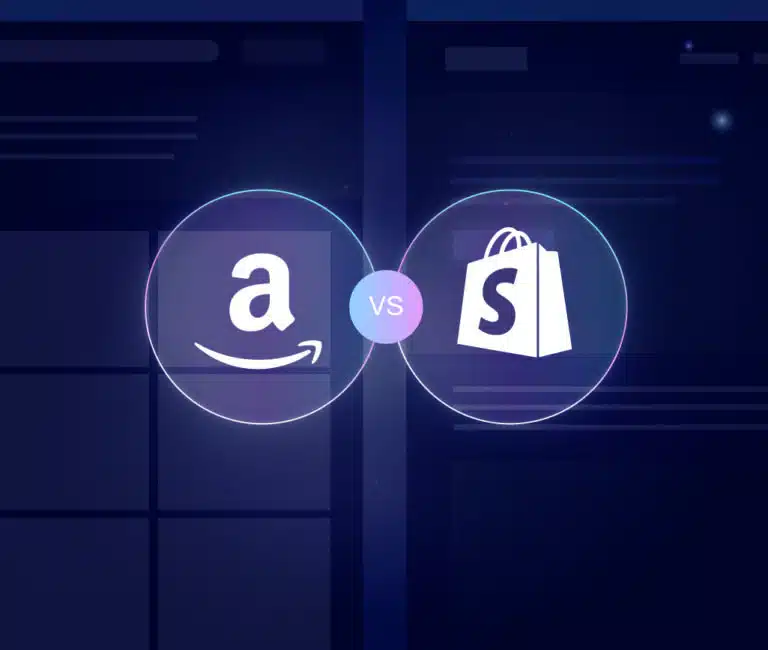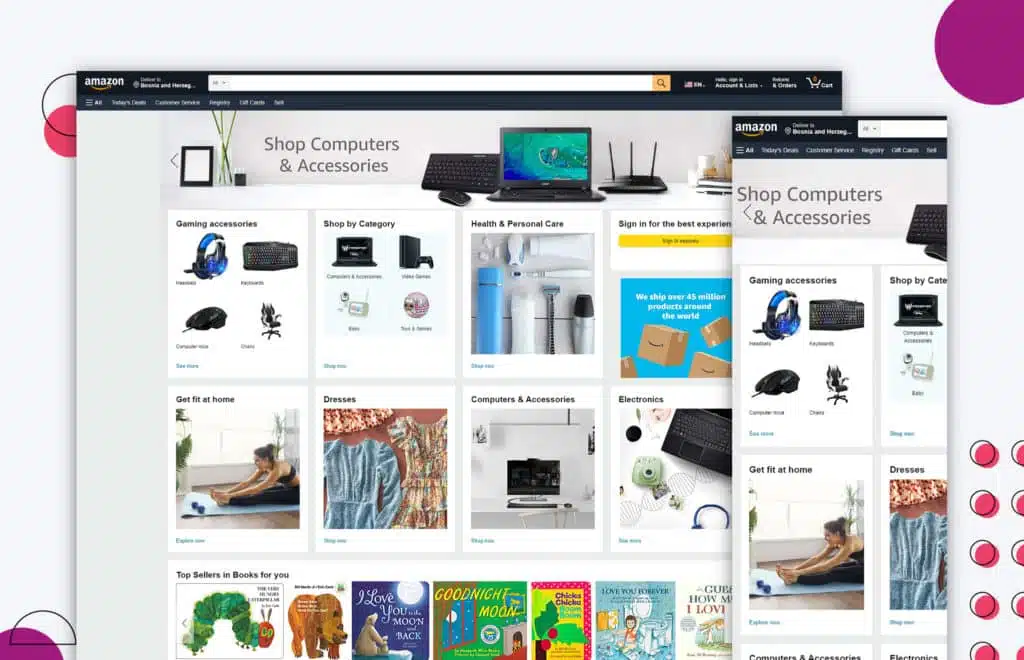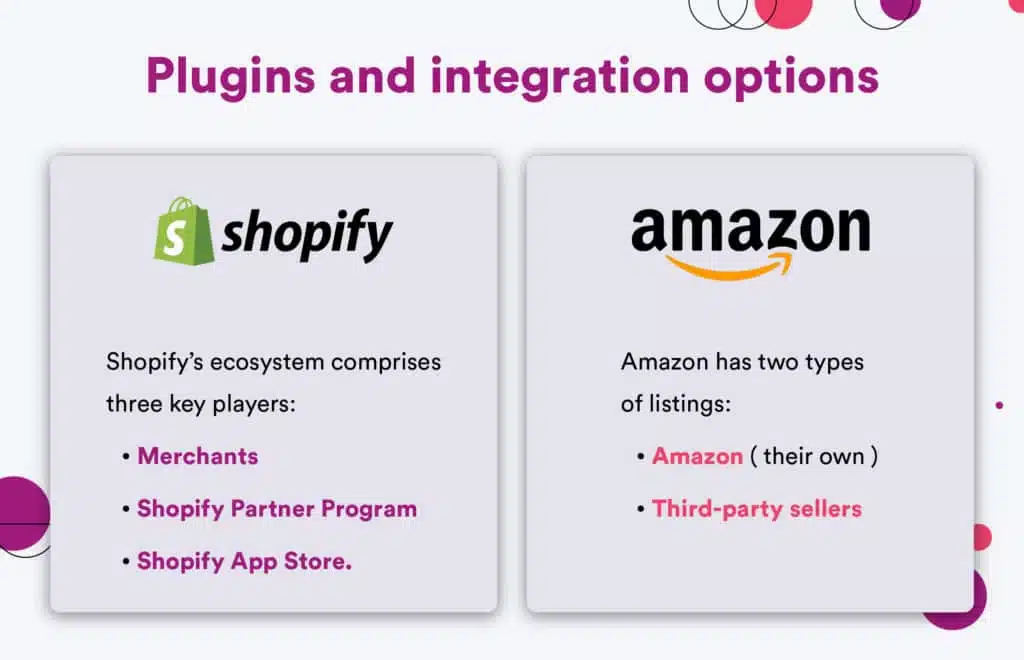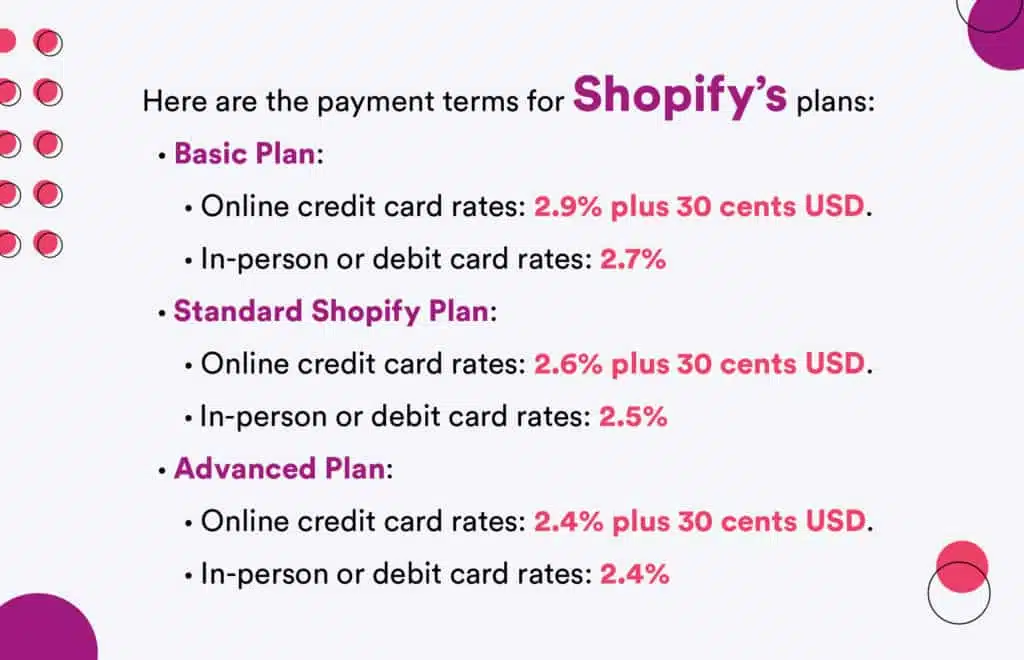Shopify
13 minute read
Shopify vs Amazon: A Battle of eCommerce.
LAST UPDATED:
June 22, 2023


Everyone and their mother is using Shopify or Amazon to sell products online.
They’re both great platforms, but they have their differences.
Shopify is a platform that allows you to create and build your website. You can choose from various templates and designs or create your own.
Shopify is great for those who want complete control over their website and brand.
Amazon, on the other hand, is an online marketplace. You can list your products on Amazon and reach a vast audience of potential customers.
Amazon is great for those who want to get their products in front of as many people as possible.
Which one should you use?
Let’s answer that by delving deeper into each platform’s offers and features.
Before going into details, let’s first discuss the origins of these two platforms to understand how they’re used.
Shopify

Shopify was founded in 2006 by Tobias Lütke, Daniel Weinand, and Scott Lake.
They were looking for a way to create an online store for their snowboarding company, and they couldn’t find anything that fit their needs, so they made Shopify!
Shopify quickly became popular among other small businesses looking for an easy way to build an online store.
Today, Shopify is used by over half a million companies in 175 countries.
Amazon

Jeff Bezos founded Amazon in 1994.
He started Amazon as an online bookstore but it quickly expanded to sell other items like electronics, toys, apparel, and more.
Today, Amazon is the world’s largest online marketplace. There are over two billion products listed on the site; the company ships to over 190 countries.
That’s the end of our quick history lesson for both platforms.
Now, let’s see how they stack up against each other:
While you can sell your products and services on both platforms, they have different features that can make them ideal for your specific needs.
Let’s explore these differences and find out which platform is best for you.
Subscription Costs
The first one we’ll discuss is their subscription costs.
Shopify
Shopify offers three monthly packages: a basic plan, a standard Shopify plan, and an advanced plan.
- The Basic Plan ($29) is best for new eCommerce businesses that have occasional in-person sales. It includes basic reports, two staff accounts, four inventory locations, and up to a 77% shipping discount.
- The Standard Shopify Plan ($79) is best for growing businesses selling online or in-store. It includes professional reports, five staff accounts, five inventory locations, and an 88% shipping discount.
- The Advanced Plan ($299) is best for scaling businesses that require advanced reporting. It includes a custom report builder, 15 staff accounts, eight inventory locations, and up to 88% shipping discount.
Amazon
Meanwhile, Amazon uses a two-tiered subscription model for its sellers:
- An Individual Plan ($0.99 per item sold) is perfect for sellers that sell 40 units or less per month. It includes the most basic Amazon seller features like adding new products to the Amazon catalog and Fulfillment by Amazon (FBA).
- Amazon Professional Plan ($39.99) grants you access to basic Amazon features and advanced features like running promotions, API integrations, and creating reports. This is perfect for growing businesses that want to advertise their products.
Verdict
Shopify is an excellent option for those who want to create an online store without breaking the bank.
Their subscription plans come with different features and they offer packages starting at $29 per month, giving you access to hosting and essential marketing tools like SEO optimization or social media promotion.
If cost isn’t something that concerns you (or if it does, but there’s always some other factor involved), then Amazon makes sense as well — though be aware of their “per item” fee disclosure before signing up, so nobody gets upset later on.
Theme Design & Customization
Online selling is about standing out from the competition, and there’s no better way to do that than customizing your online storefront.
In this section, we’ll discuss the difference between these platforms in theme design, development, and customization.
Shopify
Shopify offers a wide range of both free and premium templates that you can use to create your online store.
Templates are available for businesses of all types, such as clothing and fashion, electronics, and more.
Shopify’s templates are fully responsive, meaning they’ll look great on any device, from a desktop computer to a mobile phone.
They’re easy to customize to match your brand’s colors, logos, fonts, and more.
Amazon
Since Amazon doesn’t have a platform for third-party sellers, there are no official Amazon themes.
However, there are plenty of Shopify and WordPress themes that Amazon’s website layout has inspired.
Regarding customization, Amazon gives you a few options to choose from.
You can add your logo, change the color scheme, and add some HTML code to customize the look and feel of your store.
Verdict
Shopify is the clear winner when it comes to theme development and customization.
With a wide range of free and premium templates, Shopify has everything you need to create a beautiful and unique online store.
Amazon, on the other hand, offers no templates or themes for its third-party sellers. This leaves Amazon at a disadvantage if you want to create a custom-branded storefront.

Marketability is probably the key differentiator for choosing Shopify over Amazon. Shopify provides your business with a unique URL that you can drive traffic to from advertising and social channels. Shopify’s platform makes it easy to integrate with most major advertising platforms as well as quick setup to market products directly via social channels seamlessly.
Christi Carnahan, Digital Strategist
Sales Features
Another vital feature to consider is their sales features.
After all, you want to maximize sales on their platform as you pay for their subscription.
These two platforms offer similar sales functionalities, so you can never go wrong with their sales features.
However, there are some nuances that you need to know about.
Shopify
Shopify offers discount codes that you can use to incentivize customers.
This could be a percentage off their purchase or a shipping discount on certain products.
You can also create buy one get one (BOGO) codes to encourage people to buy more from your store.
Amazon
Amazon also offers promotional codes that you can use to drive sales.
However, these are primarily for third-party sellers and not those selling through Amazon’s platform.
Nevertheless, you can still use these codes to offer discounts to customers.
Verdict
Both Shopify and Amazon offer great sales features that will help you boost your online store’s sales.
There is no clear winner here, as both platforms are equally good in this regard, so it comes down to personal preference.
Plugins and Integrations

Another way to customize your online storefront is through plugins and integrations. They’re not just for show.
Plugins and integrations are used to improve the user experience for your customers and increase customer conversions.
These two platforms take different approaches when it comes to this.
Shopify
Shopify’s ecosystem comprises three key players: merchants, Shopify Partner Program members, and the Shopify App Store.
Merchants are Shopify’s customers — the ones who use Shopify to build their online stores.
The Shopify Partner Program is a group of agencies, app developers, designers, and other experts who are familiar with Shopify.
They can help merchants with all aspects of their store, from design to marketing to technical support.
(Fun Fact: We’ve been a Shopify Partner since 2016!)
Shopify Partners have experienced eCommerce professionals who can give you advice and support specific to the Shopify platform.
Last, but not least, the Shopify App Store has a collection of add-ons that can be purchased to improve your website. These are third-party apps that range in price from free to paid.
Amazon
Amazon has two types of listings: their own and those from third-party sellers.
Products from Amazon’s warehouses are more likely to be authentic because they go through a more rigorous checking process.
However, even though Amazon does check for fake listings, it can be harder to control because they aren’t always shipping products.
That’s why it’s essential to be aware of the different listings on Amazon and carefully read the descriptions before making a purchase.
Verdict
If you’re looking for a more customizable eCommerce platform, Shopify is the way to go. With Shopify, you have more control over your online store’s look, feel, and functionality.
Additionally, Shopify’s ecosystem is designed to support merchants at every stage of their business — from those just starting to those ready to scale.
On the other hand, if you’re looking for a platform that is already established and has a wide range of products available, Amazon is a good option.
However, it’s essential to be aware of the different listings on Amazon and carefully read the descriptions before making a purchase.
SEO
Search engine optimization is a critical factor for the success of eCommerce businesses.
Keeping your store’s SEO at peak health is essential. Both of these platforms offer features that may help you with it.
Shopify
Shopify makes it easy to optimize your site for better search engine visibility.
When you first create a Shopify store, the platform suggests you tailor your content and website structure to improve your SEO.
Over time, Shopify suggests that you look into additional factors to improve your store’s ranking in search results.
These additional factors include the number of natural links linking to your store from other websites, your website’s authority based upon engagement and other factors, and the age of your domain name.
Amazon
The main functionality of SEO on Amazon’s website is to help search for product listings. This is done via a search engine and on their website with internal search capabilities.
They focus on keywords people use when looking for certain products.
However, they also consider other factors, such as the customer’s location and language.
Additionally, they constantly update their algorithms to ensure that their results are as accurate and relevant as possible.
In other words, SEO on Amazon’s website is all about helping customers find the correct product listings — and they’re pretty good at it.
Verdict
You can’t go wrong with either platform if you’re looking for a robust option for SEO.
The goal of SEO is for potential customers to find your product online, and both platforms help you achieve that.
Payment Options and Transaction Fees

You must consider payment options when setting up a store on these platforms.
Shopify
As we mentioned, Shopify has three subscription options. Each of these options requires a flat monthly fee plus a fee for each product sold.
Here are the payment terms for Shopify’s plans:
Basic Plan:
- Online credit card rates: 2.9% plus 30 cents USD.
- In-person or debit card rates: 2.7%
Standard Shopify Plan:
- Online credit card rates: 2.6% plus 30 cents USD.
- In-person or debit card rates: 2.5%
Advanced Plan:
- Online credit card rates: 2.4% plus 30 cents USD.
- In-person or debit card rates: 2.4%
As you can see, Shopify will still charge you for each sale you make, but it’s not a confusing model to follow.
Amazon
On the other hand, Amazon has a complex payment model. However, most of the legwork is shouldered by the seller.
You’ll have to pay for different options, such as:
- Inventory fees
- Rental book service fees
- High-volume listing fees
- Refund administration fee
This is on top of your selling plan, referral fees, and fulfillment fees, which can compound and complicate your costs if you don’t keep a close eye on them.
Verdict
The obvious winner for this category is Shopify.
Their payment options and transaction fees don’t play if/when games, making it easier to track your costs for every transaction.
Shipping and Fulfillment

Shopify and Amazon offer shipping and fulfillment for their merchants.
However, there are also crucial differences between these two platforms that can affect your decision.
Shopify
Shopify’s shipping and fulfillment services are available to all merchants in their platform — and there’s no extra charge.
All you need to do is send your inventory to Shopify, and they’ll take care of the rest. This includes packing and shipping orders, as well as tracking them.
You can also choose to have Shopify handle customer service for you, which can be a lifesaver if you’re running a high-volume store.
Amazon
Amazon’s shipping and fulfillment services are available only to specific merchants in their platform — those enrolled in their Fulfillment by Amazon (FBA) program.
If you’re not enrolled in this program, you’ll have to take care of shipping and fulfillment yourself.
This can be daunting, especially if you’re running a high-volume store.
Enrolling in the FBA program has its own requirements and costs, which can be prohibitive for some merchants.
Additionally, Amazon doesn’t offer customer service for FBA orders unless you’re enrolled in their Premium Shipping Services program.
Verdict
The winner for this category is Shopify.
Their shipping and fulfillment services are available to all merchants at no extra cost. Additionally, they offer customer service for those who need it.
On the other hand, Amazon’s shipping and fulfillment services are only available to specific merchants, and they have additional requirements and costs that may be prohibitive for some businesses.
Security
Security is another factor you need to consider when choosing the right platform. Here’s what Shopify and Amazon have to offer in terms of security.
Shopify
Shopify is PCI-DSS compliant, which means they follow the standards for processing credit card information online.
They also have a dedicated security team that works around the clock to keep your store safe.
Additionally, all Shopify plans come with a free SSL certificate, which lets users know the website is secure to use and protects their information.
Amazon
Amazon has an A-Z Guarantee for all orders processed through its platform. This is a security feature that Amazon offers to its customers.
However, anything that does not fall under the Fulfillment by Amazon program is less secure.
This means that if a customer orders something from Amazon that the company does not fulfill, there is a chance that the order may not be as secure as it could be.
Verdict
The winner for this category is Shopify.
They are PCI-DSS compliant and have a dedicated security team to keep your store safe. Additionally, all plans come with a free SSL certificate.
Amazon is less secure for orders that they do not fulfill.
Maintenance Costs and Long-Term Support
The last factor you must consider is maintenance costs and long-term support.
After all, your eCommerce store is a long-term investment, so you’ll want to ensure that it receives long-term support without incurring too many expenses.
Shopify
Shopify provides users with peace of mind by ensuring their platform is secure and always up-to-date with the latest features and security patches.
You’ll never have to worry about paying for costly updates or maintenance fees down the road.
What’s more, is that their 24/7 support team is always on standby to help you with any issues or questions you may have — no matter how big or small.
Amazon
Amazon makes updates in the background that don’t always affect their sellers, but when they do, it’s often in a big way.
While Shopify makes minor, more frequent changes, Amazon’s changes can significantly impact their sellers.
Verdict
Shopify is the clear winner when it comes to maintenance and support.
They have a team of experts that are constantly working to keep their platform secure and up-to-date, and they also offer 24/7 support in case you ever need help with anything.
For several reasons, Shopify is a great eCommerce platform, but security is always a top priority.
With Shopify, you can be assured that your data is secure with their PCI-DSS compliance and SSL certificate.
Plus, their hosting features are top-notch, so you can always count on your site to be up and running.
If you ever need help, their 24/7 support team is always there to lend a hand.
If you’re looking for a platform with a wide variety of products and sellers, Amazon is the place to be.
With millions of products available, you’re sure to find what you’re looking for — and at a competitive price.
What’s more, Amazon’s search engine is potent, so if you know what you want, you can easily find it.
As a seller on Amazon, you have a lot of freedom when pricing your products.
If you want to be competitive, you can certainly do so.
So, which platform is right for you? It depends on your goals and what you’re looking to get out of your eCommerce experience.
If you want more control over your website, products, and brand, Shopify is a great option.
But if you’re looking to start selling products as quickly as possible and don’t want the hassle of managing a website yourself, Amazon may be a better choice.
Regardless of which platform you choose, we can help! Our team of experts is always here to bounce ideas off and offer support when needed.
Contact us today to learn more about our eCommerce services — we can’t wait to hear from you!
Get Memorable Insights.
Sign up to receive actionable web design advice directly in your inbox monthly.
Get Memorable Insights.
Sign up to receive actionable web design advice directly in your inbox monthly.
Author
Jeff Gapinski is the President of Huemor where he helps plan the long-term strategic growth of the agency. Jeff is passionate about UI/UX, demand generation, and digital strategy.
What Do You Think?
Have feedback? Maybe some questions? Whatever it is, we'd love to hear from you.




![Website Design Standards We Follow [That You Should Too!]](https://huemordev.b-cdn.net/wp-content/uploads/2021/12/2023.04.04.Website-Design-Standards-We-Follow-That-You-Should-Too.jpg.webp)



No comments found